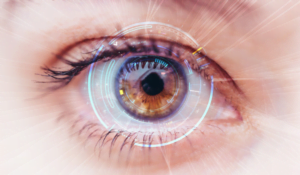
You’re not alone if you’ve ever had tired eyes from using the computer for an extended period of time. Computer eye strain is a common problem with several underlying causes.
The Problem of Dry Eyes
Dry eyes are one of the main causes of eye tiredness when using a computer. In general, staring at a screen causes us to blink less frequently, which causes less tears to form and subsequently causes dryness. To keep our eyes lubricated and comfortable, we must blink.
Light blues in blue
The blue light that screens emit is another element that contributes to eye fatigue. Since blue light has a shorter wavelength than other colors, it scatters more in the eye, making it harder for the eyes to focus. Long-term blue light exposure can cause fatigue and pain.
Vision Alters as We Age
Our eyes’ capacity to focus may deteriorate with age, necessitating the use of prescription lenses for clearer and more comfortable vision. Regular eye exams are crucial to detect any changes in the power of your glasses.
The Ripple Effect Lumbar and Neck Pain
Long durations of computer use can lead to neck and back pain, headaches, and other problems, which can make it harder to see clearly.
How to reduce computer eye strain
Fortunately, there are a few things you can do to reduce computer eye strain:
- Frequently Break: Give your eyes a rest by looking away from the screen for a few seconds once every 20 minutes. This straightforward technique greatly lessens eye strain.
- Blink More Regularly: While using a computer, remind yourself to frequently blink. Your eyes stay hydrated and pleasant by blinking.
- Reset the screen’s settings: To lessen the effects of blue light, lower the screen’s brightness and color temperature.
The right ergonomics should be used while setting up your desk, with the screen at eye level and at the right distance from your eyes.
The Expertise of the Optometrist
An optometrist can help you pinpoint the underlying reasons of your eye fatigue and offer individualized solutions. For preserving ideal eye health and treating visual changes as you age, routine eye exams are essential.
Conclusion
Computer eye strain is a frequent problem, but you may lessen its effects on your daily life by making a few easy adjustments and taking good care of your eyes. Put your eye health first and utilize the suggested techniques for relaxing and effective computer use.
Frequently asked questions
Although extended exposure to blue light may strain the eyes and make them uncomfortable, there is currently no proof that it damages the eyes permanently. However, minimizing exposure to blue light and establishing good screen habits are advantageous.
To track changes in vision and eye health, it’s essential to have a thorough eye exam at least every two years, or more frequently as prescribed by your optometrist.
Yes, reducing blue light exposure and easing eye strain during extended computer use are possible with blue light filters or screen protectors.
It’s doubtful that computer eye strain alone will result in long-term vision issues. If ignored, it could cause discomfort and indicate more vision problems that need to be addressed.
Following the 20-20-20 rule (taking a 20-second break every 20 minutes to look at anything 20 feet away) will help relax your eye muscles and lessen fatigue, even whi





Recent Articles:

Alleviating Digital Eye Strain: Tips for Screen Users

The Truth About Seeing in the Dark

The Myth of Green Improving Eyesight

The Dangers of Looking Directly at the Sun

The Risks of Using Smartphones in the Dark on Eye Health

An Examination of Visual Phenomena for “Ghost Images”




